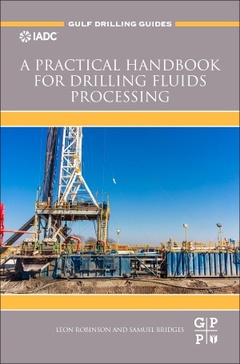Description
A Practical Handbook for Drilling Fluids Processing
Gulf Drilling Guides Series
Authors: Bridges Samuel, Robinson Leon
Language: English
Subject for A Practical Handbook for Drilling Fluids Processing:
Keywords
Addition Section; Agitation; Agitators; Apex; API; Api rp 13c; Backflow; Balancing a cone; Barite; Barite recovery; Barium Sulfate; Bentonite; Bernoulli Principle; Blending; Blow-out prevention; Bowl; Bypass; Cake; Calendaring; Carrying Capacity Index; Carrying capacity index; Cascade Systems; Cavitation; Cement placement; Centrifugal Pump; Centrifugal Pump Curves; Centrifugal pump efficiency; Centrifugal Pump sizing; Centrifugal Pumps; Centrifugal pumps; Centrifuge; Centrifuges; Chemical treatment; Cleaning efficiency; Cleanout; Colloidal solids; Compressibility; Conductance; Cone pressure; Cones; Constant Head; Cut point; Cut point curve; Cut Points; Cut points; Cuttings; Cuttings Carrying; D10; D100; D100 Cut Point; D40; D50; D90; Darcy’s Law; Decanting; Degassers; Density; Density of low gravity solids; Desander; Desanders; Design; Desilter; Desilters; Deviated Wells; Dilution; Discard dryness; Discard ratio; Discharge solids; Double Deck Shakers; Dril String concentricity; Drilled solids; Drilled solids size; Drilling Fluid Type; Drilling Fluids; Drilling fluids; Drilling fluids processing system; Drilling fluids systems; Drilling performance; Dryer Shakers; Dual centrifuging; Economics; Electric Stability; Energy; Entrained Air; Feed solids; Field example; Filter cake; Filtration; Flow Distribution; Flow distribution chamber; Formation damage; Founder point; Fracture induced; Friction; Frictional Losses; Funnel Viscosity; G Factor; Gel Strength; Going in hole; Guidelines
622 p. · 19x23.3 cm · Hardback
Description
/li>Contents
/li>Readership
/li>Biography
/li>Comment
/li>
A Practical Handbook for Drilling Fluids Processing delivers a much-needed reference for drilling fluid and mud engineers to safely understand how the drilling fluid processing operation affects the drilling process. Agitation and blending of new additions to the surface system are explained with each piece of drilled solids removal equipment discussed in detail. Several calculations of drilled solids, such as effect of retort volumes, are included, along with multiple field methods, such as determining the drilled solids density. Tank arrangements are covered as well as operating guidelines for the surface system.
Rounding out with a solutions chapter with additional instruction and an appendix with equation derivations, this book gives today?s drilling fluid engineers a tool to understand the technology available and step-by-step guidelines of how-to safety evaluate surface systems in the oil and gas fields.
2. Mud Tank Arrangements Needed for Safety
3. Addition Section
4. Agitation
5. Drilled Solids Removal
6. Shale Shakers
7. Sand Traps
8. Degassers and Mud Gas Separators
9. Hydrocyclones
10. Mud Cleaners
11. Centrifuges
12. Surface Drilling Fluid Systems
13. Removal Section
14. Centrifugal Pumps
15. Drilled Solids Calculations
16. Fraction of Drilling Fluid Processed
17. Equipment Solids Removal Efficiency
18. Cut Points
19. Cuttings Transport
20. Dilution
21. Tank Arrangements Found on Rigs
22. Operating Guidelines for Mud Tank Systems
23. Solutions to Chapter Problems
24. Appendix
Drilling fluid engineers; petroleum researchers; mud engineers; petroleum engineering graduate level students; petroleum engineers
Leon Robinson is retired after a nearly 40-year career with a major operator and a 25-year career as a drilling instructor. Previously, he taught physics at Clemson, University of Chattanooga and North Carolina State College. He was a research engineer and research advisor with a major operator, traveling to 35 countries working on drilling operations. Leon graduated with a Bachelor of Science in Industrial Physics from Clemson, a Master of Science in Physics from Clemson, and a PhD. in Engineering Physics from North Carolina State College. He has published and authored multiple articles, papers, and chapters, including one book, and earned over 55 patents. He is a member of many organizations such as Society of Petroleum Engineers and Pi Epsilon Tau and was awarded induction into the AADE Hall of Fame and the SPE Drilling Legend award.
- Presents practical guidance from real example problems that are encountered on drilling rigs
- Helps readers understand multiple field methods and drilled solids calculations with the help of practice questions
- Gives readers what they need to master each piece of drilling fluid processing equipment, including mud cleaners and safe mud tank arrangements




